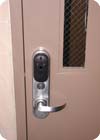Under the Wire

Dual technology cards can combine a proximity credential for
use with a door access system but also can serve as an identification and debit
card. Photo courtesy of Schlage, IR Security & Safety

Wired or wireless access card readers also can control
elevator access.
Universities and other community-like facilities consider the idea of converting from mechanical keys to an electronic access control platform. Dual technology cards are often used, with the doors being unlocked by proximity readers and the cards also hold magnetic stripe data that is used for the other campus debit card needs. Such cards also serve as student or employee identification.
“I see a huge opportunity in access control,” according to Kevin Estes, president, Sonitrol of Indianapolis, Ind. “Access control is a gift to us that just keeps on giving, so I don’t see any short-term end to this growth. I see us continuing to grow 10 to 15 percent a year.” Enterprise end users agree and cite the Federal Information Processing Standard (FIPS) 201 for smart cards as one reason for optimism as the cards are introduced to government and industrial facilities. Another driver – biometrics – goes hand-in-hand (no pun intended) with smart cards.
“We are anticipating continued smart card growth,” said Tam Hulusi, Ph.D., executive vice president, HID Global, Irvine, Calif. More experienced and sophisticated customers see the value of convergent applications. Today’s buyers see security as an infrastructure investment. End users also are adding additional services to the list of solutions through electronic access control systems -- monitoring how many people enter a door and providing mustering reports during emergencies, to name two.
“We’re seeing a lot more work that has to do with globalization and enterprise systems where we’re talking access control. We have done a lot in terms of the IT world and have embraced what we will call convergence,” said Raymond Dean, president, PEI Systems Inc., Long Island City, N.Y. End users look to companies such as PEI to assist them in that transition, to move toward the IT side of convergence.
But IT people often can’t put in door hardware and put in readers. Security Magazine research shows that, with card access, chief security officers need a higher level of installation expertise.
Looking for a reprint of this article?
From high-res PDFs to custom plaques, order your copy today!





